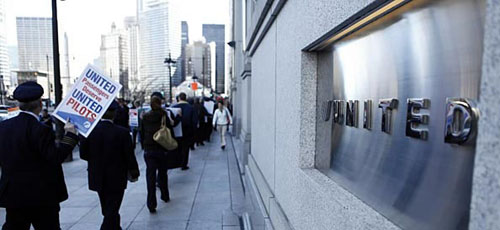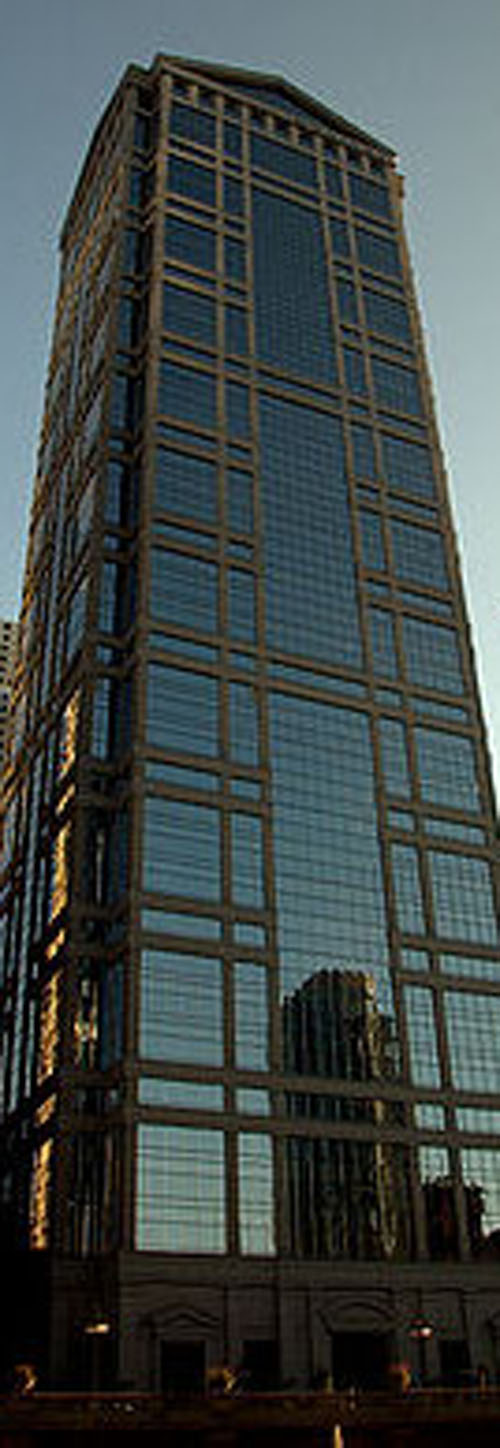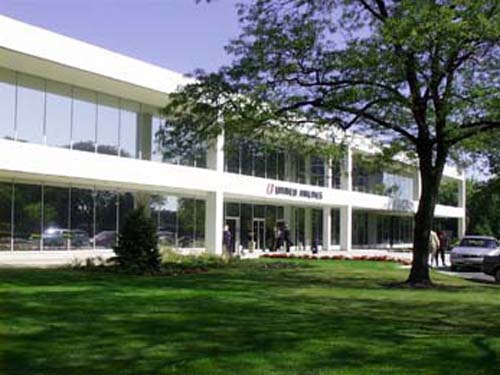United Airlines received $31 million! Corporate giants received Chicago TIF money, records show
New investigations into Chicago's controversial TIF (Tax Increment Financing) program shows that the money mostly did not go to helping development in "blighted" areas, but instead went to some of the city's largest corporate giants and with no public accountability. The TIF program, which was tightly controlled by Mayor Richard M. Daley, siphoned hundreds of millions of dollars that would have gone to the schools and put it into TIF funds that were under the mayor's control. He then doled them out at his discretion.
 United Airlines pilots picketed UAL headquarters at 77 W. Wacker Drive in Chicago (above) on St. Patrick's Day (March 17) 2010 after United entered into an agreement with Irish Aer Lingus to fly the airlines' routes to Ireland using non-union pilots. The TIF money that went to United helped with the stunning building in downtown Chicago (hardly a blighted corner, at Wacker and Dearborn above) and failed to provide the promised jobs for Chicago. At the same time, Mayor Daley had his appointed schools chiefs (Arne Duncan and Ron Huberman during the height of the TIFs; now Terry Mazany) claiming that the school system had huge "deficits" (and, among other things, had to cut back on payments into the Chicago Teachers Pension Fund) and had to make draconian cuts. To take just one example, the elimination of more than 1,300 teachers and additional non-teachers during the summer of 2010 would have been completely unnecessary had the TIF dollars been available to the public schools, thereby forcing the Board to stop claiming it has the "deficit" it claimed. On June 15, 2010, the Board set the stage for the massive layoffs by declaring a "fiscal emergency" based on Huberman's "deficit" claims.
United Airlines pilots picketed UAL headquarters at 77 W. Wacker Drive in Chicago (above) on St. Patrick's Day (March 17) 2010 after United entered into an agreement with Irish Aer Lingus to fly the airlines' routes to Ireland using non-union pilots. The TIF money that went to United helped with the stunning building in downtown Chicago (hardly a blighted corner, at Wacker and Dearborn above) and failed to provide the promised jobs for Chicago. At the same time, Mayor Daley had his appointed schools chiefs (Arne Duncan and Ron Huberman during the height of the TIFs; now Terry Mazany) claiming that the school system had huge "deficits" (and, among other things, had to cut back on payments into the Chicago Teachers Pension Fund) and had to make draconian cuts. To take just one example, the elimination of more than 1,300 teachers and additional non-teachers during the summer of 2010 would have been completely unnecessary had the TIF dollars been available to the public schools, thereby forcing the Board to stop claiming it has the "deficit" it claimed. On June 15, 2010, the Board set the stage for the massive layoffs by declaring a "fiscal emergency" based on Huberman's "deficit" claims.
How is this for a stunner: "Of the $1.2 billion [TIF dollars] designated for private sector projects since 2000, nearly half was earmarked for some of the area’s most profitable corporations. City officials approved financing for Quaker Oats, CareerBuilder, UPS, Target and Jewel-Osco, among others," according to a recent investigation by reporters from the Columbia College journalism program in Chicago (see below).
News stories in Chicago are beginning to notice the corruption in the TIF programs. The following is one of them. For those who can't utilize the hotlink above to get to the story, the URL is:
http://www.nytimes.com/2011/02/27/us/27cnctif.html?_r=1&adxnnl=1&adxnnlx=1299299031-KFOjgw9rHwpm64u2IuIq9A&pagewanted=print
February 26, 2011, Corporate Giants Received TIF Money, Records Show, By ELLYN FORTINO and MARGARET SMITH
 The United building at 77 W. Wacker in Chicago was helped along with TIF financing, money that could have gone to the schools and should have gone to "blighted" areas.During the mayoral campaign, Chicagoans heard a great deal about tax increment financing, including frequent criticism that the program, Mayor Richard M. Daley’s favorite economic development tool, gave big tax breaks to downtown businesses and left neighborhoods short.
The United building at 77 W. Wacker in Chicago was helped along with TIF financing, money that could have gone to the schools and should have gone to "blighted" areas.During the mayoral campaign, Chicagoans heard a great deal about tax increment financing, including frequent criticism that the program, Mayor Richard M. Daley’s favorite economic development tool, gave big tax breaks to downtown businesses and left neighborhoods short.
An analysis of public records by ChicagoTalks, a news Web site produced by Columbia College Chicago, shows that TIF subsidies benefited dozens of profitable companies — many of them in Chicago’s thriving downtown — while little money went to struggling, outlying neighborhoods. South Lawndale and Auburn-Gresham, for example, received no subsidies over the last decade.
The TIF program was designed to eradicate blight, add jobs and spur economic growth. It supports public and private sector projects including infrastructure, parks, schools and corporate subsidies. Of the $1.2 billion designated for private sector projects since 2000, nearly half was earmarked for some of the area’s most profitable corporations. City officials approved financing for Quaker Oats, CareerBuilder, UPS, Target and Jewel-Osco, among others.
More than half of the city’s 171 TIF projects are clustered in or near the Loop. Money was also given to cultural institutions, some in the downtown area.
Many critics question whether the program should be used to benefit nonprofits like the Chicago Symphony Orchestra, which received $2.5 million. TIF money also went to market-rate housing developments, including downtown condominium buildings.
Kate Piercy, director of government reform at the Illinois Policy Institute, said TIF districts were “created to promote economic development in blighted areas, and that’s really not even the case anymore.” Chicago has spent TIF money “in areas that nobody in their right mind can really call blighted,” Ms. Piercy said.
 How many jobs came to Chicago because of the TIF money that went to United Airlines is still unclear. Above, the United offices in El Grove Illinois.But Toby Rittner, chief executive of the Council for Development Finance Agencies, based in Columbus, Ohio, said Chicago had been a national leader in the use of TIF money. If a developer approaches Chicago officials with a sound project, chances are it will be approved, said Mr. Rittner, whose group’s membership includes the City of Chicago.
How many jobs came to Chicago because of the TIF money that went to United Airlines is still unclear. Above, the United offices in El Grove Illinois.But Toby Rittner, chief executive of the Council for Development Finance Agencies, based in Columbus, Ohio, said Chicago had been a national leader in the use of TIF money. If a developer approaches Chicago officials with a sound project, chances are it will be approved, said Mr. Rittner, whose group’s membership includes the City of Chicago.
Rachel Weber, an associate professor of urban planning and policy at the University of Illinois at Chicago, said TIF money should not be given to companies to shift jobs from one place to another within a metropolitan area. The subsidizing of corporate headquarters in the Loop is “one of the more egregious uses of TIFs,” Ms. Weber said.
An analysis of each project approved from Jan. 1, 2000, to July 30, 2010, found that nearly $600 million in TIF money was earmarked for companies. Nearly $100 million of that went to about a dozen companies as an inducement to move their corporate offices to Chicago or to remain in the city.
United Airlines, for example, was allotted about $31 million in TIF money. Mike Trevino, an airline spokesman, said the company was expected to employ more than 3,100 people in Chicago because of the subsidies. Mr. Trevino acknowledged that about 600 of those jobs were transferred from Elk Grove Village.
Some TIF money — nearly $200 million — has been approved for nonprofits, including the Spertus Institute of Jewish Studies and Rush University Medical Center, which will receive $75 million. TIF critics and officials in other cities said it was rare for nonprofits to receive this type of financing.
“You have to go back to the reason why TIFs are supposed to be created in the first place,” Ms. Piercy said, “to generate economic growth in a blighted area.”
Joe Gromacki, TIF coordinator for Madison, Wis., said it was not practical to finance such nonprofit programs because they did not pay property taxes.
Residential projects, some of which include retail space, received more than one-fourth — about $340 million — of Chicago’s TIF subsidies.
David Merriman, an economics professor and associate director of the Institute of Government and Public Affairs at the University of Illinois, said that was a “pretty dangerous fiscal policy” because residential projects cost more to service than they raise in property taxes. “So you’re giving a subsidy to something which is actually going to worsen the fiscal picture of the city,” Mr. Merriman said.
Experts question how well the Chicago Department of Housing and Economic Development monitors the use of TIF money. City officials repeatedly declined to turn over audits, progress reports and other records that were requested under the Illinois Freedom of Information Act, saying it would take too much time to find the documents.
[Caitlin Bukowski, K. Herron, Becca James, Meghan Keyes, Tony Merevick, Taryn S. Smith, Mika Tatich, Dan Weissmann and Derek Eder, all of them affiliated with ChicagoTalks, contributed reporting. ChicagoTalks.org is a local news Web site affiliated with the journalism department of Columbia College Chicago.]

